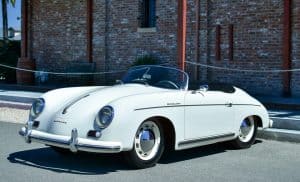People can learn more about their family heritage after an older member has passed away. The deceased might have left things hidden in attics, storage units, and garages no one knew about. Sometimes, a relative may find a steamer trunk full of precious historical items from the “old country.”
If you have some German ancestry, your grandfather, or “grossvater,” might have held on to things bequeathed to him long ago. That old trunk could contain precious ancestral photos or an Octoberfest stein with the family crest. Some things have real financial value, and some do not. A pair of custom-made golf cufflinks from Bavaria could be worth something. Those fashionable vintage earrings might be inexpensive costume jewelry. Who’s to say?
Maybe Opa left a vintage German car in storage, too! Like the well-preserved items in his old steamer trunk, this classic German auto is in good condition. But is it just a nice-looking antique car, or something more? How do you find out the value of a classic German car like a Porsche?
Americans have long enjoyed German-made luxury cars. The level of craftsmanship and mechanical innovation continues to impress us. Three commonly popular German-made cars for Americans are BMW, Mercedes, and Porsche. Any luxury cars on the showroom floor can begin at $40k and go up beyond $180k, depending on the model. It may help to know that the suitable model of a classic German car can remain on par or exceed these prices. The first thing to do is seek out a German car appraisal. And that’s what we do! From luxury German sedans to sports cars, our Dusty Cars team has appraised, bought, restored, and sold hundreds of them.
Here are a few examples:
1959 Mercedes 220s Sedan: This high-society automobile was driven by captains of industry, royalty, and self-made millionaires. The 220s Sedan isn’t a sportscar but can go from 0 to 60 in 6.1 seconds. This particular Mercedez-Benz is an inline 6-cylinder and was nicknamed the “Ponton” to reflect the distinctive pontoon-style body.
Unlock the Mystery: Let Dusty Cars Tell You if It’s Junk or Treasure
1959 Mercedes 190SL Convertible: For those with a more free spirit, 1959 offered another option that didn’t disappoint. Made with a soft top or convertible hard top, this little roadster got the public to look twice as it sped by. This flashy little two-seater looks like a sports car but was considered a “touring car” due to its weight (from 500 – 1,000 lbs more than the heaviness normal sports car). Production lasted from 1955 to 1963.
1968 Porsche 911s Coupe: Delivering a peak speed of 131 mph, this 130-horsepower model is a special situation. These 911s were not available in 1968 in the U.S. Market. Enthusiasts had to special-ship to the states to get their “Porsche fix.” All of these classic German luxury cars are of value. But if you have something that may be considered uncommon for any of these brands, we are also interested in speaking with you!
If it’s a “Special Situation,” We’re here to provide a Rare German Car Appraisal
Sometimes, someone wants to learn the value of a unique German classic car and still sell it. Our team can help with a classic car appraisal, too. There are several types of unique BMWs, Mercedes and Porsche. Here are a few examples.
BMW M1 produced from 1978 to 1981: Only 456 of these cars were built. BMW commissioned Lamborghini to create this original and provide the engine. Although there were some manufacturing issues, the vehicle still premiered at the 1978 Paris Motor Show. Slow sales gave it a short life, but today, the value is impressive.
BMW 503 Coupe: Considered both a sports car and a luxury automobile with a V8 engine. Export sales to the United States were lower than the European sales, which means only 400 were made.
Porsche 911 1982 SC Jubilee: Called the “Ferry Porsche,” a nickname bestowed on Ferdinand Porsche by his family nanny, this car had a distinctive color pallet of meteor grey exterior and burgundy interior. It’s considered “highly original.” Again, these last three are exceptional cases we usually don’t encounter.